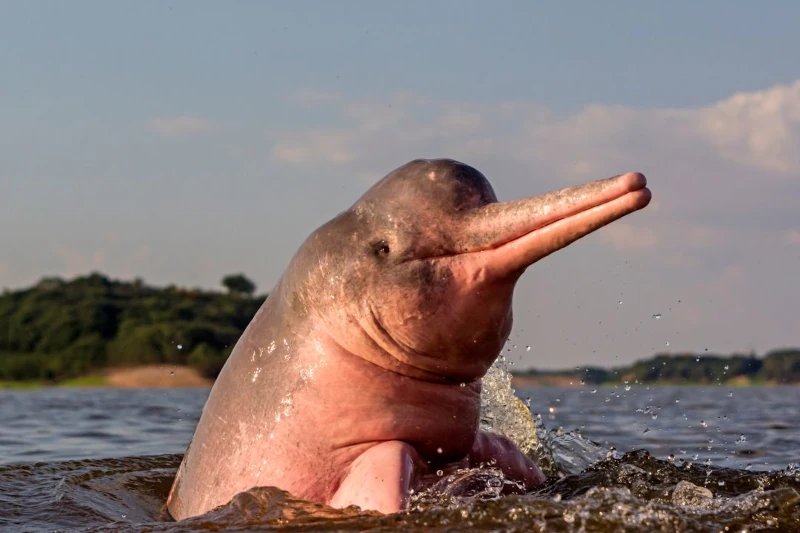
River dolphins are unique and fascinating. They’re often found in the rivers of South America, Asia, and even parts of Africa. With their slender bodies and long snouts, they’re built for navigating the twisting waterways. Unfortunately, misconceptions about these incredible animals can lead to misunderstandings about their behaviors, habitats, and threats they face. So, grab your favorite drink, and let’s dive into the common myths and misconceptions about river dolphins.
Myth 1: All Dolphins Are the Same
You might think that all dolphins are just variations of the same creature, but that’s far from the truth. River dolphins, like the Amazon river dolphin or the Ganges river dolphin, are quite different from their oceanic relatives.
While most dolphins you see in marine parks or documentaries have sleek, gray bodies, river dolphins can sport unique colors—like the pink hue of the Amazon river dolphin. Their bodies are often more elongated and slender, which helps them maneuver through the dense river habitats. They also have a different diet, relying more on fish, crustaceans, and occasionally, even small turtles. So, while they belong to the same family, their adaptations illustrate how diverse the dolphin world truly is.
To add another layer, river dolphins often have a different social structure. They aren’t typically found in large pods like ocean dolphins. Instead, they are usually solitary or found in small groups, which can affect their hunting mechanisms and communication methods. This difference alone highlights the diversity within the dolphin family.
Myth 2: River Dolphins Are Great Swimmers
You may have heard that dolphins are some of the best swimmers in the animal kingdom, but river dolphins have a few challenges that set them apart from their oceanic kin. Here’s the thing: river dolphins live in freshwater environments, and the conditions can be tricky.
Due to the obstacles in their habitat—like submerged logs, rocks, and shallow waters—river dolphins have evolved to be skilled at navigating these tight spaces rather than swimming at high speeds. Their streamlined bodies help with this, but their swimming style is not about speed; it’s more about maneuverability.
Additionally, river dolphins often use echolocation to find food and navigate. This means they rely more on sound than sight, which can be affected by the murkiness of river waters. So, while they may not be the fastest swimmers, they are deft navigators of their unique environments.
Myth 3: River Dolphins Are Not Endangered
You might be surprised to learn that many people believe river dolphins are thriving. Unfortunately, this couldn’t be further from the truth. River dolphins are facing serious threats due to habitat loss, pollution, and fishing practices.
For example, the Ganges river dolphin is listed as endangered. The construction of dams, irrigation projects, and pollution from agricultural runoff are all harming their populations. Fishing nets can entangle them, and their food sources are dwindling as their habitats change. It’s a concerning scenario that raises the question: How can we help protect these magnificent creatures?
Conservation efforts are underway, but they need more attention and support. Protecting river ecosystems benefits not only the dolphins but also the countless species they share their habitat with. So, the next time you think about river dolphins, remember the unseen challenges they face.
Myth 4: River Dolphins Are Aggressive
Another common myth is that river dolphins are aggressive animals. Honestly, this misconception could stem from the way humans have historically interacted with wild animals, including dolphins. In reality, river dolphins are generally shy and elusive.
Unlike some ocean dolphins, which can sometimes be seen exhibiting playful behaviors with boats or swimmers, river dolphins tend to avoid human interaction. They are not known to pose a threat to people. In fact, they usually prefer to stay hidden in the safety of their murky rivers.
However, like any wild animal, if they feel threatened or cornered, they may react defensively. The key takeaway here is not to label river dolphins as aggressive, but to understand their behavior within the context of their environment. Protecting their habitats is about creating a safe space for these dolphins to thrive without fear.
Myth 5: River Dolphins Are Not Intelligent
You may have encountered the idea that river dolphins aren’t as intelligent as their ocean counterparts. This myth is quite misleading. River dolphins possess complex forms of communication, social interactions, and problem-solving skills.
Studies have shown that river dolphins can use echolocation to find food and navigate their environments just like ocean dolphins. They demonstrate a remarkable ability to adapt to their surroundings. For instance, the Amazon river dolphin has learned to work cooperatively with fishermen to catch fish, showcasing intelligence and adaptability in their behavior.
Plus, intelligence in river dolphins is often harder to measure because their environments are less accessible to researchers. Just because we don’t fully understand how they think or behave doesn’t mean they’re less intelligent—it means there’s more to learn about them!
Myth 6: River Dolphins Are Not Important to Their Ecosystem
Some people think river dolphins are just another fish in the sea, but in reality, they play a crucial role in the health of their ecosystems. These dolphins help maintain the balance of their environments by regulating fish populations. When they hunt, they naturally control the numbers of various fish species, which helps ensure a balanced ecosystem.
Additionally, because they thrive in diverse habitats, their presence often indicates the health of the ecosystem. If river dolphins are struggling, it’s a red flag that something in the environment is amiss. So, when you think about biodiversity and the health of river systems, river dolphins are key players.
Supporting conservation efforts for these creatures means supporting the entire river ecosystem. Every species plays a part in the web of life, and river dolphins are an important thread in that tapestry.
As we’ve explored, river dolphins are far more complex and endangered than many myths might suggest. They bring unique qualities to their environments, and understanding these nuances is vital for their conservation.
Each myth we debunk helps paint a clearer picture of these remarkable creatures and the challenges they face. By educating ourselves and others, we can foster a better appreciation for river dolphins. Remember, these mammals are not just river dwellers; they are integral to the health of their ecosystems. Together, we can support their protection and ensure that future generations can enjoy their beauty.

